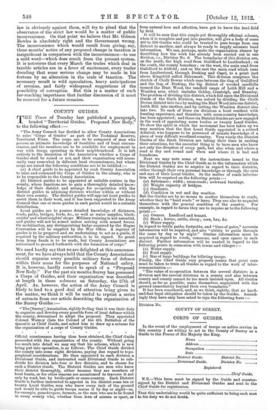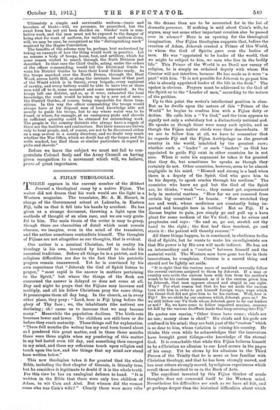COUNTY GUIDES. T HE Times of Tuesday last published a paragraph,
headed " Territorial Guides. Proposed New Body," to the following effect :— " The Army Council has decided to allow County Associations to raise ' Corps of Guides' as part of the Technical Reserve, Territorial Force. The corps are to be composed of men who possess an intimate knowledge of localities and of local circum- stances, and the members are to be available for employment in war with troops operating in their neighbourhood. It is left entirely to the discretion of the Association whether a Corps of Guides shall be raised or not, and their organization will neces- sarily vary somewhat in different local circumstances, but where corps are raised the following conditions are to be fulfilled
(a) A chief guide to be appointed by each County Association to raise and command the Corps of Guides in the county, who is to be responsible to the County Association. (b) District guides to be appointed at suitable centres in the county, whose functions are to gain a thoroughly detailed know- ledge of their district and arrange for co-operation with the district guides in adjoining districts whether within or without their own county. The district guides will appoint local guides to assist them in their work, and it has been suggested to the Army Council that one or more guides in each parish would be a suitable distribution.
Local guides are to possess detailed knowledge of distances, roads, paths, bridges, fords, &c., as well as water supplies, black- smiths' and wheelwrights' shops. Military training is not essential, and guides will not be armed unless serving with armed forces. On mobilization, any distinguishing badge required by the Hague Convention will be supplied by the War Office. A register of guides is to be prepared and an undertaking to act as a guide, if required by the military authorities, is to be signed. No grant from Army funds is to be made, but County Associations are authorized to proceed forthwith with the formation of corps."
We need hardly say that we are delighted at this announce- ment, for we have always held that the County Associations should organize every possible military form of defence -within their areas for the purposes of National safety. It is, however, hardly correct to speak of a "Proposed New Body." For the past six months Surrey has possessed a Corps of Guides, and their organization was described at length in these columns on Saturday, the 27th of April. As, however, the action of the Army Council is likely to lead to a good deal of attention being given to the matter, we think it will be useful to reprint a series of extracts from our article describing the organization of the Surrey Guides :- " The [Surrey] Association, rightly feeling that it was their duty to organize and develop every possible form of local defence within the county, determined to adopt the proposal. They appointed Colonel Watney (late the Colonel of the 4th Battalion of the Queen's) as Chief Guide, and asked him to draw up a scheme for the organization of a corps of County Guides.
• • • Official countenance having thus been obtained, the Chief Guide proceeded with the organization of the county. Without going too much into detail we may say that his scheme, which is now being put into operation, is as follows : The Chief Guide divided the county into some eight divisions, paying due regard to topo- graphical considerations. He then appointed to each division a Divisional Guide, and instructed each Divisional Guide to sub- divide his division into four or five districts, and to choose for each a District Guide. The District Guides are men who know their district thoroughly, either because they are members of local hunts, or for other reasons are accustomed to traverse it not only by road, but by bridle-path or cross-country. Each District Guide is further instructed to appoint in his district some ten or twenty Local Guides, men who know every inch of the ground and would be able to guide troops across it by day or night—as, for example, gamekeepers, farmers, or the men who are to be found in every county who, whether from love of science or sport, or from natural love and affection, have got to know the land field. by field.
It will be seen that this simple yet thoroughly efficient scheme,, when it is complete and put into practice, will give a body of some 400 to 500 Guides who could be trusted to pass troops from one district to another, and always be ready to supply accurate local information. We can, perhaps, make the organization clearer by describing how the work has already been carried out in one division, i.e., Division No. 6. The boundaries of this division are, on the north, the high road from Guildford to Leatherhead; on the south, the county boundary; on the west, the main road from Guildford to Aldfold ; and on the east the main road which runs from Leatherhead, through Dorking and Capel, to a point just above Kingsfold called Shiremark. This division comprises the stretch of Chalk Downs which runs between the Gap of Guildford and the Gap of Dorking, the big district of wooded sandhills termed the Hurt Wood, the sandhill range of Leith Hill and a Wealden area which includes Ockley, Cranleigh, and Bromley. The problem of dividing this district, which fell upon the Divisional Guide of the Sixth Division, was solved by dividing the Chalk Downs district into two by making the Hurt Wood into one district, Leith Hill into another, and by cutting the Wealden district also into two. To each of these six divisions a local resident with hunting experience, and therefore with cross-country knowledge, has been appointed; and these six District Guides are now engaged in the work of appointing some twelve or twenty Local Guides. To show the spirit in which the movement has been taken up we may mention that the first Local Guide appointed is a retired Admiral, who happens to be possessed of minute knowledge of a piece of very difficult woodland country. Very wisely the District Guides of the Sixth Division are taking their time in making their selections, for the essential thing is to have men who know not only the direction of every path, but also when and where a road is dry and sound and when and where it is bad and foundrous.
Next we may note some of the instructions issued to the Divisional Guides by the Chief Guide as to the information which the District Guides are to acquire in regard to their districts, either through their own personal knowledge or through the eyes and ears of their Local Guides. In the matter of roads informa- tion will be required on the following points :- (a) Substance ; width; cross-roads ; awkward turnings. (b) Weight capacity of bridges. (c) Gradients.
(d) Condition in wet and dry weather. But the Guides are by no means to confine themselves to roads, whether they be "hard roads" or lanes. They are also to acquaint themselves with the general condition of the country. For example, in regard to farms they are to inquire as to the following points :- (a) Owners. Landlord and tenant.
(b) Stock ; horses, cattle, sheep ; corn, hay, &c. (c) Water supply.
In regard to bridle paths, footpaths, and "lines of gates," accurate information will be required, and also "ability to guide through the same by day or by night." Similar information must be acquired in regard to woods, commons, and open spaces in each district. Further information will be wanted in regard to the following points in connexion with towns and villages :— (a) Water supply.
(b) Food supply.
(c) Size of large buildings for billeting troops. Finally, the Chief Guide very properly insists that great care must be taken to train all Guides in regard to the work of inter- communication :—
" The value of co-operation between the several districts in a division and the several divisions in a county and also between county and county cannot be too much insisted upon. All Guides should, as far as possible, make themselves acquainted with the ground immediately beyond their own botusdaries."
It has been considered, and, as we think, rightly, that no hard- and-fast legal obligation should be taken by the Guides. Accord- ingly they have only been asked to sign the following form :— Division No. COUNTY OF SURREY.
CORPS OF GUIDES.
In the event of the employment of troops on active service in this country I am willing to act in the County of Surrey as a Guide to the Forces of His Majesty the King.
Name Address Occupation Date District Guide. District No
Divisional Guide. Division No.
Registered Chief Guide.
N.B.—This form must be signed by the Guide and counter- signed by the District and Divisional Guides and sent to the Chief Guide for registration.
That this undertaking would be quite sufficient to bring each man to his duty we do not doubt.
Ultimately a simple and serviceable uniform—tunic and breeches of khaki—will, we presume, be prescribed, but the exact form has not yet been decided on. Guides' work is com- bative work, and the men must not be exposed to the danger of being shot for want of uniform, for uniform, and uniform alone, will, we may be sure, be recognized as the " distinguishing mark" required by the Hague Convention. The benefits of the scheme may be, perhaps, best understood by taking an example of how the thing would work in practice. Let us assume a body of troops, horse, foot, and artillery, which for some reason wished to march through the Sixth Division just described. In that case the Chief Guide, acting under the orders of the officer commanding, would tell the Divisional Guide to warn his District Guides to have their Local Guides ready. As the troops marched over the North Downs, through the Hurt Wood, across Leith Hill, or along the intricate lanes of that part of the Weald which is in Surrey, every brigade, every regiment of cavalry, and every battery would be able to have two or three men told off to it, some mounted and some unmounted. As the troops left one district, and so, as it were, exhausted the local knowledge, the work would be taken up by a new set of men- the District Guides, of course, being responsible for these tran- sitions. In this way the officer commanding the troops would always have at his disposal men of local knowledge able not merely to guide his troops, but to say where water was to be found, or where, for example, at an emergency picks and shovels in sufficient quantity could be obtained for entrenching work. The people in the country districts who always have a supply of these are the builders and contractors. But their names are known only to local people, and, of course, are not to be discovered either on a map or even in a county directory, and we doubt very much whether the War Office, which no doubt has all the forges and the wells marked, has filed these or similar particulars in regard to picks and shovels."
Before we leave the subject we must not fail to con- gratulate Colonel Seely and the Army Council on having given recognition to a movement which will, we believe, prove of great importance.











































 Previous page
Previous page